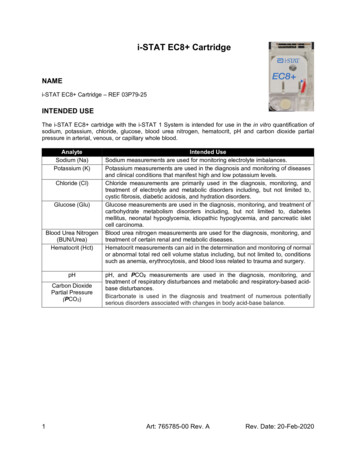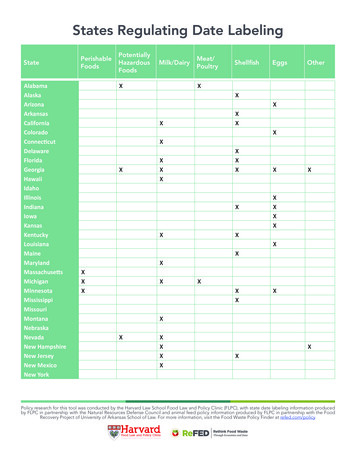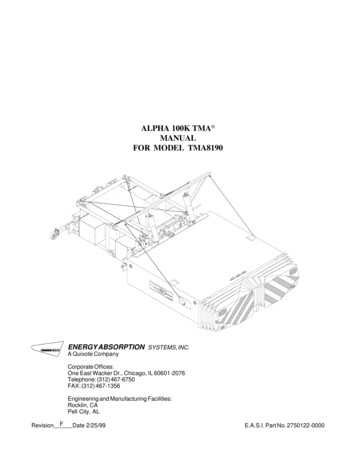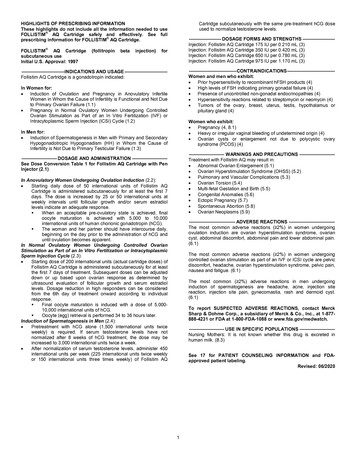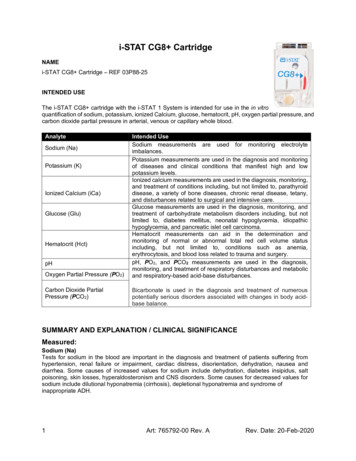
Transcription
i-STAT CG8 CartridgeNAMEi-STAT CG8 Cartridge – REF 03P88-25INTENDED USEThe i-STAT CG8 cartridge with the i-STAT 1 System is intended for use in the in vitroquantification of sodium, potassium, ionized Calcium, glucose, hematocrit, pH, oxygen partial pressure, andcarbon dioxide partial pressure in arterial, venous or capillary whole blood.AnalyteSodium (Na)Potassium (K)Ionized Calcium (iCa)Glucose (Glu)Hematocrit (Hct)pHOxygen Partial Pressure (PO2)Carbon Dioxide PartialPressure (PCO2)Intended UseSodium measurements are used for monitoring electrolyteimbalances.Potassium measurements are used in the diagnosis and monitoringof diseases and clinical conditions that manifest high and lowpotassium levels.Ionized calcium measurements are used in the diagnosis, monitoring,and treatment of conditions including, but not limited to, parathyroiddisease, a variety of bone diseases, chronic renal disease, tetany,and disturbances related to surgical and intensive care.Glucose measurements are used in the diagnosis, monitoring, andtreatment of carbohydrate metabolism disorders including, but notlimited to, diabetes mellitus, neonatal hypoglycemia, idiopathichypoglycemia, and pancreatic islet cell carcinoma.Hematocrit measurements can aid in the determination andmonitoring of normal or abnormal total red cell volume statusincluding, but not limited to, conditions such as anemia,erythrocytosis, and blood loss related to trauma and surgery.pH, PO2, and PCO2 measurements are used in the diagnosis,monitoring, and treatment of respiratory disturbances and metabolicand respiratory-based acid-base disturbances.Bicarbonate is used in the diagnosis and treatment of numerouspotentially serious disorders associated with changes in body acidbase balance.SUMMARY AND EXPLANATION / CLINICAL SIGNIFICANCEMeasured:Sodium (Na)Tests for sodium in the blood are important in the diagnosis and treatment of patients suffering fromhypertension, renal failure or impairment, cardiac distress, disorientation, dehydration, nausea anddiarrhea. Some causes of increased values for sodium include dehydration, diabetes insipidus, saltpoisoning, skin losses, hyperaldosteronism and CNS disorders. Some causes for decreased values forsodium include dilutional hyponatremia (cirrhosis), depletional hyponatremia and syndrome ofinappropriate ADH.1Art: 765792-00 Rev. ARev. Date: 20-Feb-2020
Potassium (K)Tests for potassium in the blood are important in the diagnosis and treatment of patients suffering fromhypertension, renal failure or impairment, cardiac distress, disorientation, dehydration, nausea anddiarrhea. Some causes of increased values for potassium include renal glomerular disease,adrenocortical insufficiency, diabetic ketoacidosis (DKA), sepsis and in vitro hemolysis. Some causes ofdecreased values for potassium include renal tubular disease, hyperaldosteronism, treatment of DKA,hyperinsulinism, metabolic alkalosis and diuretic therapy.Ionized Calcium (iCa)Although most of the calcium in blood is bound to protein or complexed to smaller anionic species, thebiologically active fraction of calcium is free ionized calcium. Through its role in a number of enzymaticreactions and in membrane transport mechanisms, ionized calcium is vitally important in blood coagulation,nerve conduction, neuromuscular transmission and in muscle contraction. Increased ionized calcium(hypercalcemia) may result in coma. Other symptoms reflect neuromuscular disturbances, such ashyperreflexia and/or neurologic abnormalities such as neurasthenia, depression or psychosis. Decreasedionized calcium (hypocalcemia) often results in cramps (tetany), reduced cardiac stroke work anddepressed left ventricular function. Prolonged hypocalcemia may result in bone demineralization(osteoporosis) which can lead to spontaneous fractures. Measurements of ionized calcium have proven ofvalue under the following clinical conditions: transfusion of citrated blood, liver transplantation, open heartsurgery, neonatal hypocalcemia, renal disease, hyperparathyroidism, malignancy, hypertension andpancreatitis.Glucose (Glu)Glucose is a primary energy source for the body and the only source of nutrients for brain tissue.Measurements for determination of blood glucose levels are important in the diagnosis and treatment ofpatients suffering from diabetes and hypoglycemia. Some causes for increased values of glucose includediabetes mellitus, pancreatitis, endocrine disorders (e.g., Cushing’s syndrome), drugs (e.g., steroids,thyrotoxicosis), chronic renal failure, stress, or I.V. glucose infusion. Some causes of decreased values ofglucose include insulinoma, adrenocortical insufficiency, hypopituitarism, massive liver disease, ethanolingestion, reactive hypoglycemia, and glycogen storage disease.Hematocrit (Hct)Hematocrit is a measurement of the fractional volume of red blood cells. This is a key indicator of the body’sstate of hydration, anemia or severe blood loss, as well as the blood’s ability to transport oxygen. Adecreased hematocrit can be due to either overhydration, which increases the plasma volume, or adecrease in the number of red blood cells caused by anemias or blood loss. An increased hematocrit canbe due to loss of fluids, such as in dehydration, diuretic therapy, and burns, or an increase in red bloodcells, such as in cardiovascular and renal disorders, polycythemia vera, and impaired ventilation.pHpH is an index of the acidity or alkalinity of the blood with an arterial pH of 7.35 indicating an acidemiaand 7.45 alkalemia 1.Oxygen Partial Pressure (PO2)PO2 (partial pressure of oxygen) is a measurement of the tension or pressure of oxygen dissolved in blood.Some causes for decreased values of PO2 include decreased pulmonary ventilation (e.g. airway obstructionor trauma to the brain), impaired gas exchange between alveolar air and pulmonary capillary blood (e.g.,bronchitis, emphysema, or pulmonary edema), and alteration in the flow of blood within the heart or lungs(e.g., congenital defects in the heart or shunting of venous blood into the arterial system withoutoxygenation in the lungs).Rev. Date: 20-Feb-2020Art: 765792-00 Rev. A2
Carbon Dioxide Partial Pressure (PCO2)PCO2 along with pH is used to assess acid-base balance. PCO2 (partial pressure of carbon dioxide), therespiratory component of acid-base balance, is a measure of the tension or pressure of carbon dioxidedissolved in the blood. PCO2 represents the balance between cellular production of CO2 and ventilatoryremoval of CO2 and a change in PCO2 indicates an alteration in this balance. Causes of primary respiratoryacidosis (increase in PCO2) are airway obstruction, sedatives and anesthetics, respiratory distresssyndrome, and chronic obstructive pulmonary disease. Causes of primary respiratory alkalosis (decreasedPCO2) are hypoxia (resulting in hyperventilation) due to chronic heart failure, edema and neurologicdisorders, and mechanical hyperventilation.TEST PRINCIPLEThe i-STAT System uses direct (undiluted) electrochemical methods. Values obtained by direct methodsmay differ from those obtained by indirect (diluted) methods. 2Measured:Sodium (Na), Potassium (K) and ionized Calcium (iCa)The respective analyte is measured by ion-selective electrode potentiometry. In the calculation of results,concentration is related to potential through the Nernst equation.Glucose (Glu)Glucose is measured amperometrically. Oxidation of glucose, catalyzed by the enzyme glucose oxidase,produces hydrogen peroxide (H2O2). The liberated H2O2 is oxidized at the electrode to produce a currentproportional to the sample glucose concentration.Hematocrit (Hct)Hematocrit is determined conductometrically. The measured conductivity, after correction for electrolyteconcentration, is inversely related to the hematocrit.pHpH is measured by direct potentiometry. In the calculation of results for pH, concentration is related topotential through the Nernst equation.PO2PO2 is measured amperometrically. The oxygen sensor is similar to a conventional Clark electrode. Oxygenpermeates through a gas permeable membrane from the blood sample into an internal electrolyte solutionwhere it is reduced at the cathode. The oxygen reduction current is proportional to the dissolved oxygenconcentration.PCO2PCO2 is measured by direct potentiometry. In the calculation of results for PCO2, concentration is relatedto potential through the Nernst equation.Temperature “Correction” AlgorithmpH, PO2, and PCO2 are temperature-dependent quantities and are measured at 37 C. The pH, PO2, andPCO2 readings at a body temperature other than 37 C can be ‘corrected’ by entering the patient’stemperature on the chart page of the analyzer. In this case, blood gas results will be displayed at both 37 C3Art: 765792-00 Rev. ARev. Date: 20-Feb-2020
and the patient’s temperature.The pH, PO2, and PCO2 at the patient’s temperature (Tp) are calculated as follows 3:Calculated:HCO3, TCO2, and BE HCO3 (bicarbonate), the most abundant buffer in the blood plasma, is an indicator of the bufferingcapacity of blood. Regulated primarily by the kidneys, HCO3 is the metabolic component of acid-basebalance.TCO2 is a measure of carbon dioxide which exists in several states: CO2 in physical solution or looselybound to proteins, bicarbonate (HCO3) or carbonate (CO3) anions, and carbonic acid (H2CO3).Measurement of TCO2 as part of an electrolyte profile is useful chiefly to evaluate HCO3 concentration.TCO2 and HCO3 are useful in the assessment of acid-base imbalance (along with pH and PCO2) andelectrolyte imbalance. The calculated TCO2 provided by the i-STAT System is determined from the measured and reportedvalues of pH and PCO2 according to a simplified and standardized form of the Henderson-Hasselbalchequation. 3 This calculated TCO2 measurement is metrologically traceable to the i-STAT pH and PCO2measurements, which are in turn traceable to primary standard reference materials for pH and PCO2.Like all calculated parameters reported by the i-STAT System, the user can independently determineTCO2 values from the reported pH and PCO2 measurements using a combination of the equation forHCO3 given in the PCO2. Base excess of the extracellular fluid (ECF) or standard base excess is defined as the concentration oftitratable base minus the concentration of titratable acid when titrating the average ECF (plasma plusinterstitial fluid) to an arterial plasma pH of 7.40 at PCO2 of 40 mmHg at 37 C. Excess concentrationof base in the average ECF remains virtually constant during acute changes in the PCO2 and reflectsonly the non-respiratory component of pH‑disturbances.When a cartridge includes sensors for both pH and PCO2, bicarbonate (HCO3), total carbon dioxide(TCO2) and base excess (BE) are calculated. 3log HCO3 pH log PCO2- 7.608TCO2 HCO3 0.03PCO2BEecf HCO3-24.8 16.2(pH-7.4)BEb (1 - 0.014*Hb) * [ HCO3 - 24.8 (1.43 * Hb 7.7) * (pH - 7.4) ]sO2 sO2 (oxygen saturation) is the amount of oxyhemoglobin expressed as a fraction of the total amount ofhemoglobin able to bind oxygen (oxyhemoglobin plus deoxyhemoglobin).Rev. Date: 20-Feb-2020Art: 765792-00 Rev. A4
sO2 is calculated from measured PO2 and pH and from HCO3 calculated from measured PCO2 and pH.However, this calculation assumes normal affinity of oxygen for hemoglobin. It does not take intoaccount erythrocyte diphosphoglycerate (2,3-DPG) concentrations which affect the oxygen dissociationcurve. The calculation also does not take into account the effects of fetal hemoglobin or dysfunctionalhemoglobins (carboxy-, met-, and sulfhemoglobin). Clinically significant errors can result fromincorporation of such an estimated sO2 value for oxygen saturation in further calculations, such as shuntfraction, or by assuming the value obtained is equivalent to fractional oxyhemoglobin.HemoglobinThe i-STAT System provides a calculated hemoglobin result which is determined as follows 4:hemoglobin (g/dL) hematocrit (% PCV) x 0.34hemoglobin (g/dL) hematocrit (decimal fraction) x 34To convert a hemoglobin result from g/dL to mmol/L, multiply the displayed result by 0.621. The calculationof hemoglobin from hematocrit assumes a normal MCHC.See below for information on factors affecting results. Certain substances, such as drugs, may affectanalyte levels in vivo. 5 If results appear inconsistent with the clinical assessment, the patient sample shouldbe retested using another cartridge.REAGENTSContentsEach i-STAT cartridge contains one reference electrode, sensors for the measurement of specific analytes,and a buffered aqueous calibrant solution that contains known concentrations of analytes andpreservatives. A list of reactive ingredients relevant for the i-STAT CG8 cartridge is indicated below:SensorReactive Ingredient Biological SourceMinimum QuantityNaSodium (Na )N/A121 mmol/LKPotassium (K )N/A3.6 mmol/L2 iCaCalcium (Ca )N/A0.9 mmol/LGluGlucoseGlucose OxidaseN/AAspergillus niger7 mmol/L0.002 IUpHHydrogen Ion (H )N/A6.66 pHPCO2Carbon Dioxide (CO2)N/A25.2 mmHgWarnings and Precautions 5For in vitro diagnostic use.Cartridges are intended for single-use only. Do not reuse.Refer to the i-STAT 1 System Manual for all warnings and precautions.Art: 765792-00 Rev. ARev. Date: 20-Feb-2020
Storage Conditions Refrigerated at 2-8 C (35-46 F) until expiration date.Room Temperature at 18-30 C (64-86 F). Refer to the cartridge box for shelf life.INSTRUMENTSThe i-STAT CG8 cartridge is intended for use with the i-STAT 1 analyzer.SPECIMEN COLLECTION AND PREPARATION FOR ANALYSISSpecimen TypesArterial, venous or capillary whole blood.Sample Volume: 95 µLBlood Collection Options and Test Timing (time from collection to cartridge GlucoseHematocritSyringes*WithoutanticoagulantTest Timing3 minutesEvacuated TubesWithoutanticoagulantTest Timing3 minutesWithbalancedheparinanticoagulant (orlithiumheparinanticoagulant forpH, PCO2, andPO2 only)(syringe must befilledpermanufacturer'srecommendation) Maintainanaerobicconditions. oagulant10 minutesWith lithium heparinanticoagulant(tubes must be filledper manufacturer'srecommendation) Maintainanaerobicconditions. Remixthoroughlybeforefillingcartridge.10 minutes3 minutesWithoutanticoagulant3 minutes30 minutesWith lithium heparinanticoagulant(tubes must be filledper manufacturer'srecommendation) Remixthoroughlybeforefillingcartridge,30 parinanticoagulant(syringe must befilledpermanufacturer'srecommendation) Remixthoroughlybeforefillingcartridge.Rev. Date: 20-Feb-2020Art: 765792-00 Rev. ACapillary TubesWith balancedheparinanticoagulantorTestTiming3 minuteslithium heparinif labeled for themeasurement ofelectrolytes (forpH, PCO2, andPO2 only)With balancedheparinanticoagulantor3 minuteslithium heparinif labeled for themeasurement ofelectrolytes6
PROCEDURE FOR CARTRIDGE TESTINGEach cartridge is sealed in a foil pouch for protection during storage--do not use if pouch has beenpunctured.o A cartridge should not be removed from its protective pouch until it is at room temperature (18-30 C or 64-86 F). For best results, the cartridge and analyzer should be at room temperature.o Since condensation on a cold cartridge may prevent proper contact with the analyzer, allowrefrigerated cartridges to equilibrate at room temperature for 5 minutes for a single cartridge and 1hour for an entire box before use.o Use a cartridge immediately after removing it from its protective pouch. Prolonged exposure maycause a cartridge to fail a Quality Check.o Do not return unopened, previously refrigerated cartridges to the refrigerator.o Cartridges may be stored at room temperature for the time frame indicated on the cartridge box.Filling and Sealing the Cartridge (after cartridge has been equilibrated and blood sample has beencollected)1. Place the cartridge on a flat surface.2. Mix the sample thoroughly. Invert a lithium heparin blood collection tube at least 10 times. Ifsample was collected into a syringe, invert syringe for 5 seconds then roll the syringe between thepalms (hands parallel to the ground) for 5 seconds, flip and roll for an additional 5 seconds. Theblood in the hub of the syringe will not mix, therefore expelling 2 drops before filling a cartridge isdesired. Note that it may be difficult to properly mix a sample in a 1.0 mL syringe.3. Fill the cartridge immediately after mixing. Direct the hub of syringe or tip of the transfer device(capillary tube, pipette, or dispensing tip) into the sample well of the cartridge.4. Slowly dispense sample into the sample well until the sample reaches the fill mark indicated on thecartridge. Cartridge is properly filled when the sample reaches the ‘fill to’ mark and a small amountof sample is in the sample well. The sample should be continuous, no bubbles or breaks (seeSystem Manual for details).5. Fold the snap closure over the sample well.Performing Patient Analysis1. Press the power button to turn on the handheld.2. Press 2 for i-STAT Cartridge.3. Follow the handheld prompts.4. Scan the lot number on the cartridge pouch.5. Continue normal procedures for preparing the sample, and filling and sealing the cartridge.6. Push the sealed cartridge into the handheld port until it clicks into place. Wait for the test to complete.7. Review the results.For additional information for cartridge testing, refer to the i-STAT 1 System Manual located atwww.pointofcare.abbott.Analysis TimeApproximately 130–200 secondsQuality ControlThe i-STAT quality control regimen comprises four aspects, with a system design that reduces theopportunity for error, including:7Art: 765792-00 Rev. ARev. Date: 20-Feb-2020
1. A series of automated, on-line quality measurements that monitors the sensors, fluidics, andinstrumentation each time a test is performed.2. A series of automated, on-line procedural checks that monitors the user each time a test isperformed.3. Liquid materials are available to be used to verify the performance of a batch of cartridges whenthey are first received or when storage conditions are in question. The performance of thisprocedure is not a manufacturer’s system instruction.4. Traditional quality control measurements that verify the instrumentation using an independentdevice, which simulates the characteristics of the electrochemical sensors in a way that stressesthe performance characteristics of the instrumentation.For additional information on Quality Control, refer to the i-STAT 1 System Manual located atwww.pointofcare.abbott.Calibration VerificationCalibration Verification is a procedure intended to verify the accuracy of results over the entiremeasurement range of a test. The performance of this procedure is not a manufacturer’s system instruction.However, it may be required by regulatory or accreditation bodies. While the Calibration Verification Setcontains five levels, verification of the measurement range could be accomplished using the lowest, highestand mid-levels.EXPECTED VALUESTESTMEASUREDNaKiCaGluHematocrit/HctUNITS /L% PCV EFERENCE RANGEarterialvenous100-1802.0 9.00.25 2.501.0 10.01.1 38.920 7000.20 7.0015 750.15 0.756.50 - 8.205 - 8000.7 – 106.65 - 1300.67 – 17.33138-146 63.5 4.9 6 **1.12 1.32 74.5 5.3 73.9 5.8 770 105 70.70 1.05 738 51 6 ****0.38 0.51 67.31 - 7.41******7.35 - 7.45 780 - 105 6 *****10.7 - 14.0 6 *****35 - 45 741 - 514.67 - 6.005.47 - 6.805.1 25.551 2553.2 15.812 17 6****120 170 67 11 6CALCULATEDHemoglobin/HbBicarbonate/ HCO3TCO2Base Excess/ q/L)mmol/L(mEq/L)%1.0 – 85.022 – 26******23 – 28******5 - 5023 - 2724 - 29(-30) – ( 30)(-2) – ( 3) 7(-2) – ( 3) 70-10095 – 98The i-STAT System can be configured with the preferred units. Not applicable for pH test.The reference range for potassium has been reduced by 0.2 mmol/L from the range cited inReference 6 to account for the difference in results between serum and plasma results.PCV, packed cell volume.The reference ranges for hematocrit and hemoglobin span both female and male populationsRev. Date: 20-Feb-2020Art: 765792-00 Rev. A8
***********The reference ranges shown are for a healthy population. Interpretation of blood gasmeasurements depend on the underlying condition (e.g., patient temperature, ventilation,posture and circulatory status).Calculated from Siggard-Andersen nomogram 1 .Unit Conversion:o Ionized Calcium (iCa): To convert mmol/L to mg/dL, multiply the mmol/L value by 4. To convertmmol/L to mEq/L, multiply the mmol/L value by 2.o Glucose (Glu): To convert mg/dL to mmol/L, multiply the mg/dL value by 0.055.o Hematocrit (Hct): To convert a result from % PCV (packed cell volume) to fraction packed cellvolume, divide the % PCV result by 100. For the measurement of hematocrit, the i-STAT Systemcan be customized to agree with methods calibrated by the microhematocrit reference methodusing either K3EDTA or K2EDTA anticoagulant. Mean cell volumes of K3EDTA anticoagulatedblood are approximately 2–4% less than K2EDTA anticoagulated blood. While the choice ofanticoagulant affects the microhematocrit method to which all hematocrit methods are calibrated,results from routine samples on hematology analyzers are independent of the anticoagulant used.Since most clinical hematology analyzers are calibrated by the microhematocrit method usingK3EDTA anticoagulant, the i-STAT System default customization is K3EDTA.o PO2 and PCO2: To convert PO2 and PCO2 results from mmHg to kPa, multiple the mmHg value by0.133.The reference ranges programmed into the analyzer and shown above are intended to be used as guidesfor the interpretation of results. Since reference ranges may vary with demographic factors such as age,gender and heritage, it is recommended that reference ranges be determined for the population beingtested.METROLOGICAL TRACEABILITYThe measured analytes in the i-STAT CG8 cartridge are traceable to the following reference materials ormethods. The i-STAT System controls and calibration verification materials are validated for use only withthe i-STAT System and assigned values may not be commutable with other methods.Sodium (Na) and Potassium (K) and Ionized Calcium (iCa)The respective analyte values assigned to i-STAT System controls and calibration verification materials aretraceable to the U.S. National Institute of Standards and Technology (NIST) standard reference materialSRM956.Glucose (Glu)The i‑STAT System test for glucose measures glucose amount-of-substance concentration in the plasmafraction of arterial, venous, or capillary whole blood (dimension mmol L‑1) for in vitro diagnostic use. Glucosevalues assigned to i‑STAT controls and calibration verification materials are traceable to the U.S. NationalInstitute of Standards and Technology (NIST) standard reference material SRM965.Hematocrit (Hct)The i‑STAT System test for hematocrit measures packed red blood cell volume fraction in arterial, venous,or capillary whole blood (expressed as the % packed cell volume) for in vitro diagnostic use. Hematocritvalues assigned to i‑STAT working calibrators are traceable to the Clinical and Laboratory StandardsInstitute (CLSI) H7-A3 procedure for determining packed cell volume by the microhematocrit method. 8pHThe i‑STAT System test for pH measures the hydrogen ion amount-of-substance concentration in theplasma fraction of arterial, venous, or capillary whole blood (expressed as the negative logarithm of therelative molal hydrogen ion activity) for in vitro diagnostic use. pH values assigned to i‑STAT Systemcontrols and calibration verification materials are traceable to the U.S. National Institute of Standards andTechnology (NIST) standard reference materials SRMs 186-I, 186-II, 185, and 187.9Art: 765792-00 Rev. ARev. Date: 20-Feb-2020
PO2The i‑STAT System test for oxygen partial pressure measures oxygen partial pressure in arterial, venous,or capillary whole blood (dimension kPa) for in vitro diagnostic use. PO2 values assigned to i‑STAT Systemcontrols and calibration verification materials are traceable to U.S. National Institute of Standards andTechnology (NIST) standard reference materials via commercially available certified specialty medical gasstandards.PCO2The i‑STAT System test for carbon dioxide partial pressure measures carbon dioxide partial pressurein arterial, venous, or capillary whole blood (dimension kPa) for in vitro diagnostic use. PCO2 valuesassigned to i‑STAT System controls and calibration verification materials are traceable to U.S. NationalInstitute of Standards and Technology (NIST) standard reference materials via commercially availablecertified specialty medical gas standards.Additional information regarding metrological traceability is available from Abbott Point of Care Inc.PERFORMANCE CHARACTERISTICSThe typical performance data summarized below was collected in health care facilities by health careprofessionals trained in the use of the i-STAT System and comparative methods.PrecisionPrecision data was collected in multiple sites as follows: Duplicates of each control fluid were tested in themorning and in the afternoon on five days for a total of 20 replicates. The averaged statistics are presentedbelow.TestNaUnitsmmol/L or mEq/LKmmol/L or mEq/LiCammol/LGlumg/dLHct% olLevel 1Level 3Level 1Level 3Level 1Level 3Level 1Level 3LowHighLevel 1Level 3Level 1Level 3Level 1Level .40.440.50CV (%)[Coefficientof Variation .102.52.0Method ComparisonMethod comparison data was collected using CLSI guideline EP9-A. 9Deming regression analysis 10 was performed on the first replicate of each sample. In the methodcomparison table, n is the number of specimens in the data set, Sxx and Syy refer to estimates of imprecisionbased on the duplicates of the comparative and the i-STAT methods respectively, Sy.x is the standard errorof the estimate, and r is the correlation coefficient.*Rev. Date: 20-Feb-2020Art: 765792-00 Rev. A10
Method comparisons will vary from site to site due to differences in sample handling, comparative methodcalibration and other site-specific variables.* The usual warning relating to the use of regression analysis is summarized here as a reminder. For any analyte, “ifthe data is collected over a narrow range, the estimate of the regression parameters are relatively imprecise and maybe biased. Therefore, predictions made from these estimates may be invalid” . 10 The correlation coefficient, r, can beused as a guide to assess the adequacy of the comparative method range in overcoming this problem. As a guide, therange of data can be considered adequate if r ronCX 31890.740.531.00-0.111.171261480.865Kodak EktachemTM le ’tSy.xXminXmaxrBeckmanSynchronCX 31890.0600.0550.970.020.0762.85.70.978Kodak EktachemTM rofile r LX20 352.210.691.03Sodium/Na(mmol/L or mEq/L)Venous blood samples were collectedin lithium heparin Vacutainer tubesand analyzed in duplicate on thei-STAT System.A portion of the specimen wascentrifuged and the separated plasmawas analyzed in duplicate oncomparative methods within 20minutes of collection.Potassium/K(mmol/L or mEq/L)Venous blood samples were collectedin lithium heparin Vacutainer tubesand analyzed in duplicate on thei-STAT System.A portion of the specimen wascentrifuged and the separated plasmawas analyzed in duplicate oncomparative methods within 20minutes of collection.Ionized inlithiumheparinVacutainer tubes and analyzed induplicate on the i-STAT System andon the comparative methods within10 minutes of each other.Glucose/Glu(mg/dL)Venous blood samples were collectedin lithium heparin Vacutainer tubesand analyzed in duplicate on thei-STAT System.11Art: 765792-00 Rev. ANova 2Bayer 860404.710.960.99DadeDimension RxLXpand320.980.591.01Rev. Date: 20-Feb-2020
A portion of the specimen wascentrifuged and the separated plasmawas analyzed in duplicate oncomparative methods within 20minutes of Hematocrit/Hct(% PCV)(% packed cell volume)Venous blood samples, collected inlithium heparin Vacutainer tubes,were analyzed in duplicate on thei-STATSystemandonthecomparative methods for hematocritwithin 20 minutes of s blood samples were collected inevacuated tubes and arterial sampleswere collected in blood gas syringes withlithium heparin anticoagulant.All sample were analyzed in duplicate onthe i-STAT System and on thecomparative methods within 10 minutes ofeach other. Arterial blood samples werecollected from hospital patients in 3 mLblood gas syringes and were analyzed induplicate on the i-STAT System and thecomparative method within 5 minutes ofeach TProfile -Dyn4000290.410.771.06-1.421.1319460.993Sysmex Int’tSy.xXminXmaxIL ofile iometerABL500453.702.781.023-2.62.52------0.996R
Rev. Date: 20-Feb-2020 Art: 765792-00 Rev. A 4 and the patient's temperature. The pH, PO2, and PCO2 at the patient's temperature (Tp) are calculated as follows 3: Calculated: HCO3, TCO2, and BE HCO3 (bicarbonate), the most abundant buffer in the blood plasma, is an indicator of the buffering capacity of blood. Regulated primarily by the kidneys, HCO3 is the metabolic component of acid-base
